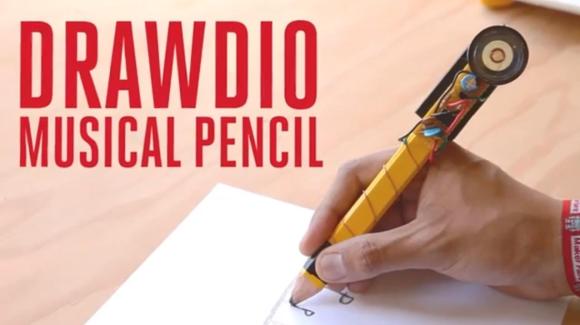
Here’s another fun weekend project for the hacker younglings, a musical synthesizer that plays different musical tones based on the resistance of your conductive graphite drawing!
Like our recent post on a DIY Metal Detector, this project makes use of the ever relevant 555 timer. Except in this case they are using a more modern TLC555 timer which only requires 3V instead of the typical 4.5V. It’s a fairly simple project that you should be able to complete in just a few hours.
The circuit is quite basic. The 555 timer outputs in astable mode, which means there is a continuous stream of pulses from pin 3 which go right into the speaker circuit. The rest of the circuit monitors the resistance of whatever the pencil is touching, including you! Changes in resistance result in the variation of pulses outputted by the 555 timer.
As always, the video guide is after the break.
The cool thing about this hack is you can draw different things, including pianos, and actually play music just by using the pencil. Because you’re part of the resistance loop, you can have quite a bit of fun drawing!















:|
:| indeed
I don’t know why you guys are :|ing. I have some kids who would love this toy. I’d like to smooth the audio a little, replace the AAAs with a coin cell, and wrap it differently, using a drill to implant the metal higher up in the pencil. Then it would need some adjustment so I can tune out the extra length of graphite. Or, maybe it’ll bring the frequency down from a squeal to something more musical.
Would be extra nice to make it so it stepped or smoothed the tone at intervals, but as a software guy I wonder if that would be more complicated, hardware-wise. Guys who know?
Looks fun. I built a similar device with my Kosmos electronics learning kit, using a MOSFET and an antenna to detect electrical fields and then convert them to audio using a 555 like in this setup.
O hai there. http://hackaday.com/2008/10/09/drawdio-kit-lets-you-make-music-while-you-draw/
YEAH RIGHT!
Well this is pretty old, you can order the whole kit over at Adafruit, which I did about two years ago.
It’s a super nice project, especially for beginners to get into soldering.
Yeah that’s an old one.
Maybe merge to two and make an LC version. Or maybe just the time it takes a wave to travel along the line and back.You wouldn’t have to time the pulses just balance the circuit and use resonance. Then you could invert and overlay the first signal to cancel out the noise. It would be a pain to get it to comply with part 15 of the fcc rules, not to mention tune the thing in the first place. ( It’s the sort of pencil Tesla might have owned :D )
As long as you don’t put out enough RF to interfere with anything outside your lab, a hobby project wouldn’t necessarily have to comply with FCC rules, you couldn’t sell it as a product but then i doubt anyone has bothered getting a approval for the original Drawdio meaning it couldn’t be sold as a product either.
I made a few Drawdio variants for a soldering exercise for new students at a university once, It is indeed possible to run a modern 555 off a 3V CR2032 battery, we also used a piezo speaker for low power consumption.
Repost, again… Hey let’s play a game everyone! Let’s link to all of the times the drawdio has been posted! Bonus points to whomever can find the very first time the drawdio was posted!
If you can “draw” your own speakers and play the sound through that, it’d be awesome.
You sort’ve… can!
http://web.media.mit.edu/~plusea/?category_name=actuators
Draw a spiral on some paper, in conductive ink. Put it near a magnet and it’s an actual speaker! Not heard it playing tho. I wonder if pencil graphite would do as a conductive ink? If only it was easy to try at home…
Pencil graphite if black and compact enough is a conductor, however as seen in the Drawdio kit it a few centimeters to tens of centimeters is several megaohms.
If you were to put enough current to move the paper in a magnetic field through a conductive track like that it would probably instantly catch fire due to the heat generated.
Ah well the site I mention use home-made silver or copper ink, with metal particles suspended in glue. Which is what it looks like, too, a primary-school class who got into the glitter cupboard. Isn’t there any *attractive* looking conductive ink? Or at least reliable conductive ink that prints flat enough, with low enough resistance, that it actually deserves calling ink, and conductive?
Anyway irrelevant, really. The site at MIT are also into conductive copper foil, I had some once, didn’t really get on with it.
So with these low-resistance methods, you CAN make a speaker by drawing a coil on a bit of paper, then putting it near a magnet! Bet the efficiency’s terrible though, but still, would be nice to see stuff like that printed onto novelty greeting cards ‘n’ stuff in the future. When print-electronics gets going a bit more.
You can already make resistors with pencil lead, I’m sure a small capacitor would be possible with a couple of parallel conductive traces with a small gap between. There’s even been experimental printable batteries! A layer at a time of whatever chemicals gives you a small battery with a few mAh that’s not much thicker than a few layers of ink.
I bet ferrite would work well in ink, too. Or printable magnets with iron powder. Printed spiral coil coated with insulator coated with printed magnet, and you’d have a flat, cheap, speaker.
i’am c.monishver . i’am doing the the project drawdio from make magazine . i don’t know what value and number of npn amplifing transistor we should use in this project.